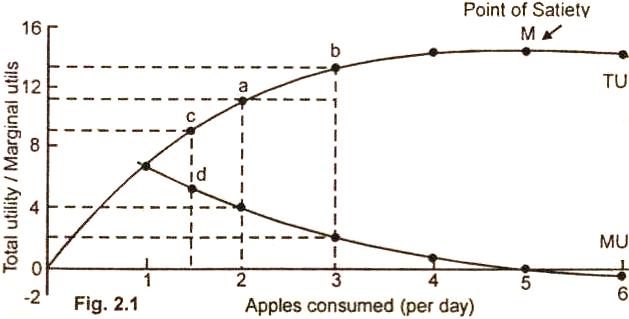Total Utility and Marginal Utility:
Difference Between Total
Utility and Marginal Utility:
People buy goods
because they get satisfaction from them. This satisfaction which the consumer
experiences when he consumes a good, when measured as number of utils is called
utility.
It is here to necessary
to make a
distinction between
total utility and marginal utility.
Total Utility (TU):
Definition and Explanation:
"Total utility
is the total satisfaction obtained from all units of a particular commodity
consumed over a period of time".
For example,
a person consumes eggs and gains 50 utils of
total utility. This total utility is the sum of utilities from the successive
units (30 utils from the first egg, 15 utils from the second and 5 utils from
the third egg).
Summing up total
utility is the amount of satisfaction (utility) obtained from consuming a
particular quantity of a good or service within a given time period. It is the
sum of marginal utilities of each successive unit of consumption.
Formula:
TUx
= ∑MUx
Marginal Utility (MU):
Definition and Explanation:
"Marginal utility means an additional or
incremental utility. Marginal utility is the change in the total utility that
results from unit one unit change in consumption of the commodity within a given
period of time".
For example, when a person increases the consumption of eggs
from one egg to two eggs, the total utility increases from 30 utils to 45 utils.
The marginal utility here would be the15 utils of the 2nd
egg consumed.
Marginal utility, thus, can also be
described as difference between total utility derived from one level of
consumption and total utility derived from another level of consumption.
Formula:
MU = ∆TU
∆Q
It may here be noted that as a person
consumes more and more units of a commodity, the marginal utility of the
additional units begins to diminish but the total utility goes on increasing at
a diminishing rate.
When the marginal utility comes to zero
or we say the point of satiety is reached, the total utility is the maximum. If
consumption is increased further from this point of satiety, the marginal
utility becomes negative and total utility begins to diminish.
The relationship between total
utility and marginal utility is now explained with the help of following
schedule and a graph.
Schedule:
|
Units of Apples Consumed Daily |
Total Utility in Utils Per Day |
Marginal Utility in Utils Per Day |
| 1 |
7 |
7 |
| 2 |
11 |
4
(11-7) |
| 3 |
13 |
2
(13-11) |
| 4 |
14 |
1
(14-13) |
| 5 |
14 |
0
(14-14) |
| 6 |
13 |
-1 (13-14) |
The above table shows that when a person
consumes no apples, he gets no satisfaction. His total utility is zero. In case
he consumes one apple a day, he gains seven units of satisfaction. His total
utility is 7 and his marginal utility is also 7.
In case he consumes second
apple, he gains extra 4 utils (MU). Thus given him a total utility of 11 utils
from two apples. His marginal utility has gone down from 7 utils to 4 utils
because he has a less craving for the second apple.
Same is the case with the
consumption of third apple. The marginal utility has now fallen to 2 utils while
the total utility of three apples has increased to 13 utils (7 + 4 + 2). In case
the consumer takes fifth apple, his marginal utility falls to zero utils and if
he consumes sixth apple also, the total showing total utility and marginal
utility is plotted in figure below:
Diagram/Curve:

(i) The total utility curves starts at
the origin as zero consumption of apples yield zero utility.
(ii) The TU curve reaches at its maximum
or a peak of M when MU is zero.
(iii) The MU curve falls through the graph.
A special point occurs when the consumer consumes fifth apple. He gains no
marginal utility from it. After this point, marginal utility becomes
negative.
(iv) The MU
curve can be derived from the total utility curve. It is the
slope of the line joining two adjacent quantities on the curve.
For example, the marginal utility of the third apple is the
slope of line joining points a and b. The slope of such given by
the formula:
MU =
∆TU
∆Q
Here MU = 2.
Relevant Articles:
|